文学术语
古代文学名词术语

名词术语:1. 初唐四杰:初唐四杰,中国唐代初年,文学家王勃、杨炯、卢照邻、骆宾王的合称。
简称“王杨卢骆”。
四杰的诗文虽未脱齐梁以来绮丽余习,但已初步扭转文学风气。
四杰正是初唐文坛上新旧过渡时期的杰出人物。
2. 沈宋:沈宋是中国初唐诗人沈佺期、宋之问的合称。
他们的五七言近体诗歌作品标志着五七言律体的定型。
沈宋以前,律诗前后失粘的相当多,且多为五律。
沈宋使五律更趋精密,完全定型;又使七律体制开始规范化,为律诗在平仄粘对、句数用韵方面的定型做出了重要的贡献,是以后作诗的人有明确的规格可以遵循。
律诗形式的定型,在诗歌发展史上具有重要意义。
3. 近体诗:近体诗又称今体诗或格律诗,是一种讲究平仄、对仗和押韵的汉族诗歌体裁。
为有别于古体诗而有近体之名。
指唐代形成的格律诗体。
在近体诗篇中句数、字数、平仄、押韵都有严格的限制。
近体诗是唐代以后的主要诗体,著名的代表诗人有:李白、杜甫、李商隐、陆游等。
在中国诗歌史上有着重要地位。
4.盛唐气象:是宋元明清时期一个文学批评的专门术语,指盛唐时期诗歌的总体风貌特征。
盛唐之时诗人们面对当时国势强大经济繁荣的局面,大抵胸襟开阔,意气昂扬,希望建功立业。
他们一是喜欢描写祖国壮丽山河,边塞奇伟的风光,紧张的战斗和自己的豪情壮志,这就形成了盛唐诗的雄壮风貌;二是对前代优秀诗歌传统的继承和发扬,盛唐诗人竭力扫除南朝至初唐的浮靡诗风。
重视向汉魏古诗乐府学习,注重发扬汉末建安时代明朗刚健的优良诗风,从诗歌本身的继承关系说,盛唐诗雄浑特征得力于此。
以后明清诗论家承严羽之说,常把雄壮浑厚二者作为盛唐诗歌的风貌特征,并称之为盛唐气象。
5.盛唐边塞诗:盛唐兴起的一个诗歌流派。
其诗长于七言,特别是七言歌行,善于描写边塞风光和战争生活,表现征人思妇的思想感情,大多具有爱国感情和进取精神,显示浓厚的生活气息,风格多慷慨悲壮。
代表诗人有王昌龄、王之涣、王翰、崔颢、李颀等,而以高适、岑参为首。
故后人也称“高岑诗派”6.高岑:盛唐诗人高适和岑参的合称,为盛唐边塞诗歌代表诗人的专称。
文学批评术语词典
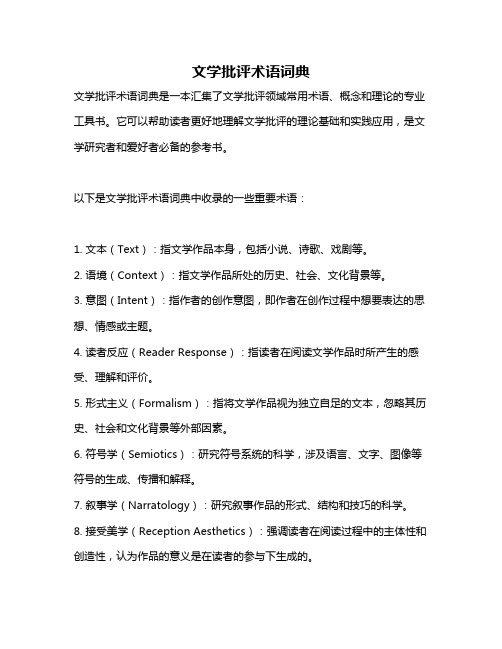
文学批评术语词典
文学批评术语词典是一本汇集了文学批评领域常用术语、概念和理论的专业工具书。
它可以帮助读者更好地理解文学批评的理论基础和实践应用,是文学研究者和爱好者必备的参考书。
以下是文学批评术语词典中收录的一些重要术语:
1. 文本(Text):指文学作品本身,包括小说、诗歌、戏剧等。
2. 语境(Context):指文学作品所处的历史、社会、文化背景等。
3. 意图(Intent):指作者的创作意图,即作者在创作过程中想要表达的思想、情感或主题。
4. 读者反应(Reader Response):指读者在阅读文学作品时所产生的感受、理解和评价。
5. 形式主义(Formalism):指将文学作品视为独立自足的文本,忽略其历史、社会和文化背景等外部因素。
6. 符号学(Semiotics):研究符号系统的科学,涉及语言、文字、图像等符号的生成、传播和解释。
7. 叙事学(Narratology):研究叙事作品的形式、结构和技巧的科学。
8. 接受美学(Reception Aesthetics):强调读者在阅读过程中的主体性和创造性,认为作品的意义是在读者的参与下生成的。
9. 结构主义(Structuralism):将文学作品视为一个整体,研究其内在的结构、关系和规律。
10. 后结构主义(Poststructuralism):对结构主义的批判和超越,强调个体主体性和文本的开放性。
这只是一小部分文学批评术语的示例,实际上,文学批评领域的术语极为丰富多样。
文学批评术语词典将会对深入理解文学批评的概念和理论提供极大的帮助。
中文文学术语

中文文学术语
1.叙事-指文本中叙述故事的方式和手法,包括时间序列、情感表达、人物塑造等方面。
2. 描写 - 指文本中对人物、物品、场景等进行具体生动的描述,展现出视觉、听觉、嗅觉、味觉等方面的细节。
3. 意象 - 指文本中使用形象的语言表达出来的抽象概念,如比喻、拟人等手法。
4. 比喻 - 指通过对两个事物的相似点进行比较,以达到给读者新的感受或理解的修辞手法。
5. 拟人 - 指将无生命的事物赋予人类的特征和行为,来表达作者的情感或增强作品的艺术效果。
6. 反讽 - 指通过说出与实际相反的话,以表达出作者的反感、批评或嘲讽。
7. 对比 - 指通过对两个相似或不同的事物进行对照,来突出文本中的主题、情感等。
8. 押韵 - 指文本中出现两个或多个音节相同的词汇,以增强诗歌、歌曲等的韵律美感。
9. 音律 - 指文本中音节的节奏、语调、音量等方面的组合,以产生艺术效果。
10. 主旨 - 指文本中的核心思想和主题,是作者所要表达的意义和观点。
- 1 -。
文学评论术语
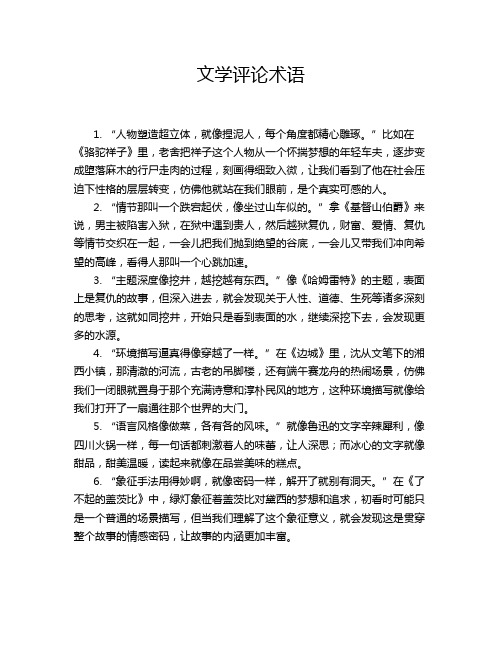
文学评论术语1. “人物塑造超立体,就像捏泥人,每个角度都精心雕琢。
”比如在《骆驼祥子》里,老舍把祥子这个人物从一个怀揣梦想的年轻车夫,逐步变成堕落麻木的行尸走肉的过程,刻画得细致入微,让我们看到了他在社会压迫下性格的层层转变,仿佛他就站在我们眼前,是个真实可感的人。
2. “情节那叫一个跌宕起伏,像坐过山车似的。
”拿《基督山伯爵》来说,男主被陷害入狱,在狱中遇到贵人,然后越狱复仇,财富、爱情、复仇等情节交织在一起,一会儿把我们抛到绝望的谷底,一会儿又带我们冲向希望的高峰,看得人那叫一个心跳加速。
3. “主题深度像挖井,越挖越有东西。
”像《哈姆雷特》的主题,表面上是复仇的故事,但深入进去,就会发现关于人性、道德、生死等诸多深刻的思考,这就如同挖井,开始只是看到表面的水,继续深挖下去,会发现更多的水源。
4. “环境描写逼真得像穿越了一样。
”在《边城》里,沈从文笔下的湘西小镇,那清澈的河流,古老的吊脚楼,还有端午赛龙舟的热闹场景,仿佛我们一闭眼就置身于那个充满诗意和淳朴民风的地方,这种环境描写就像给我们打开了一扇通往那个世界的大门。
5. “语言风格像做菜,各有各的风味。
”就像鲁迅的文字辛辣犀利,像四川火锅一样,每一句话都刺激着人的味蕾,让人深思;而冰心的文字就像甜品,甜美温暖,读起来就像在品尝美味的糕点。
6. “象征手法用得妙啊,就像密码一样,解开了就别有洞天。
”在《了不起的盖茨比》中,绿灯象征着盖茨比对黛西的梦想和追求,初看时可能只是一个普通的场景描写,但当我们理解了这个象征意义,就会发现这是贯穿整个故事的情感密码,让故事的内涵更加丰富。
7. “叙事节奏把握得就像跳舞的节拍,恰到好处。
”例如《老人与海》,海明威没有在开头就把老人的故事一股脑地倒出来,而是缓缓地、有节奏地讲述老人出海、与鱼搏斗的过程,不紧不慢,就像跳慢舞一样,每一个动作都充满力量和韵味。
8. “视角独特得像从外星人的眼睛看地球。
”《百年孤独》采用的那种魔幻现实主义的视角,讲述家族的故事,从布恩迪亚家族的兴起、繁荣到衰落,那种独特的视角就像是一个外星人在俯瞰人类社会的发展,让我们看到了很多平常看不到的东西。
文学重要术语

文学重要术语actant 行为体allegory 寓言allusion 典故,引语ambiguity 歧义,多义,暧昧,含混analogy 类推片断anima 女性潜倾animus 男性潜倾archetypal image 原型意象archetypal mode 原型模式archetypal motif 原型母题archetypal nouns 原型名词archetype 原型baroque 巴罗克catharsis 净化chinoiserie 中华风(一译中国风)close reading 细读法clusters of formulas 套语团commenia dell'arte 艺术喜剧common poetics 共同诗学comparative thematics 比较主题学comparatum 比较体complementary bipolarity 二元补衬(此语系浦安迪所创)composite images 并合意象compound image 复合意象conceit 奇喻corpus thematics 文萃主题学creation myth 开创神话cultural thematics 文化主题学deconstruction 解构defamiliarization 陌生化a derivational poetics 衍生诗学diachronic studies 历时研究dichotomy 二歧式discourse 话语discourse analysis theory 话语分析理论discursive articulation 议论式联结ecriture 写作Ego 自我episodic plot 插曲式情节,缀段式情节explicative thematics 阐释主题学extrinsic studies 外部研究fable (有关动物的)寓言fiction 虚构,小说formal realism 形式写实主义formula 套语formulaic expression 套语语句Formulaic Theory 套语理论function 功能genology 文类学genre, or literary genre 文类(即文学类型),体裁heterogeneity 非均一性the High Baroque 鼎盛巴罗克high mimetic 高模仿型Id 本我an illusion of reality 现实的幻象image 意象imagism 意象主义impersonal personality 无个性的个性interdisciplinary study 跨学科研究intersubjectivity 主体间性intertexts 交互文本intertextuality 文本间性irony 反讽itineraria 巡游juxtaposition of imagery 意象并置langue 语言larger-than-life 大于生活lexie 语汇单位leitmotif 主导母题linguistics 语言学linked plot 缀合情节literariness 文学性local texture 局部肌质locus amoenus 安乐之所logical structure 逻辑结构low mimetic 低模仿型the Mannerist style 矫饰主义风格meaning 意旨melodrama 情节剧metacriticism 元批评metafiction 元小说metalanguage 元语言metaphor 暗喻,比喻the Metaphysical style 玄学派风格metonymy 换喻,转喻mirage 幻象model 范型monomyth 单一神话motivation 动因化multiple periodicity 多项周旋(此语系浦安迪所创)mythemes 神话素Mythology 神话体系narrative code 叙事语码narrative syntagms 叙事性横组合段narratology 叙事学objective correlative 客观对应物Oedipus complex 俄狄浦斯情结oral inconsistency 口述出岔overtone 弦外之音(本意为陪音、泛音)oxymoron 矛盾修辞parable 说教寓言paradigmatic 纵聚合的paradox 悖论parody 谐摹parole 言语paronomasia 双关personality 个性,个人性philology 语文学the poetics of discontinuity 非连续诗学point of view 视点pragmatics 语用学the primordial image 原始意象the principle of equivalence 对等原则problematic individuals 疑难人物proseroman 散文传奇pseudo-statement 伪陈述Psychoanalysis 精神分析学raports de fait 实际联系retroactive reading 回味阅读rhapsody 赋saga 英雄传奇semantic formulas 语义套语semantics 语义学semiotics, semiology 符号学shadow 阴影(心理学术语)showing 显示signified 所指signifier 能指simile 明喻Stoffgeschichte 题材史stylistics 风格学Superego 超我symbol 象征symple image 单纯意象synaesthesia 联觉,通感synchronic studies 共时研究syntactic formulas 句法套语syntactics 句法学syntagmatic 横组合的syntax 句法telling 讲述tenor 喻旨tension 张力textuality 本文性thematics, thematology 主题学theme 套式(套语理论所用;暂译名)topoi 惯用话题,老套话tristia 忧郁type scenes 典型场景unitary plot 单一情节vehicle 喻体a vision of reality 现实幻象vorticism 旋涡主义Weniad 文王史诗(此词系王靖献所创)。
文学术语

1. Allegory (寓言)寓言,讽喻:一种文学、戏剧或绘画的艺术手法,其中人物和事件代表抽象的观点、原则或支配力。
2.Alliteration (头韵) 头韵:在一组词的开头或重读音节中对相同辅音或不同元音的重复。
3.Allusion (典故) 典故:作者对某些读者熟悉并能够作出反映的特定人物,地点,事件,文学作品的引用。
4.Analogy (类比) 类比:为了在两个事物之间找出差别而进行的比较。
5.Antagonist (反面主角)反面主角:叙事文学或戏剧中与男女主人公或英雄相对立的主要人物。
6.Antithesis (对仗) 对仗:两组相对的思想,言辞,词句的平衡。
7. Aphorism (警句)警句:蕴含关于人生真理的明智的看法的精练的语句。
8.Aside (旁白) 旁白:只说给观众而认为不会让台上其他演员听到的一段对话。
9.Apostrophe (呼语)呼语:直接称呼不在场或虚构的人物或称呼拟人的事物,尤指作为演讲或作文过程中的离题话。
10.Assonance (类韵)类音,类韵:相同或相似元音的重复,尤其指在诗歌中的重复。
11.Atmosphere (氛围)12.Autobiography (自传)13.Ballad (民谣)14.Ballad Stanza (民谣诗节)15.Biography (传记)传记:由他人篆写的关于某人生平的详细记录。
16.Blank Verse (无韵体诗)17.Caesura (休止)18.Canto (章) 诗章:一首长诗的主要部分之一。
19.Caricature (夸张讽刺) 夸张讽刺:为了使文中的人物显得可笑而使用的夸张或扭曲人物形象的手法。
20.Characterization (人物刻画) 人物刻画:作者表现作品中人物性格的方法。
21.Classicism (古典主义) 古典主义:一种在文学,艺术,音乐领域体现古代希腊,罗马风格的运动。
22.Climax (高潮)edy (喜剧)喜剧:轻松的和常有幽默感的或在调子上是讽刺的戏剧作品,常包括主题冲突的愉快解决24.Conceit (奇想)奇想:一种在截然不同的事物之间建立起的比喻。
外国文学名词解释
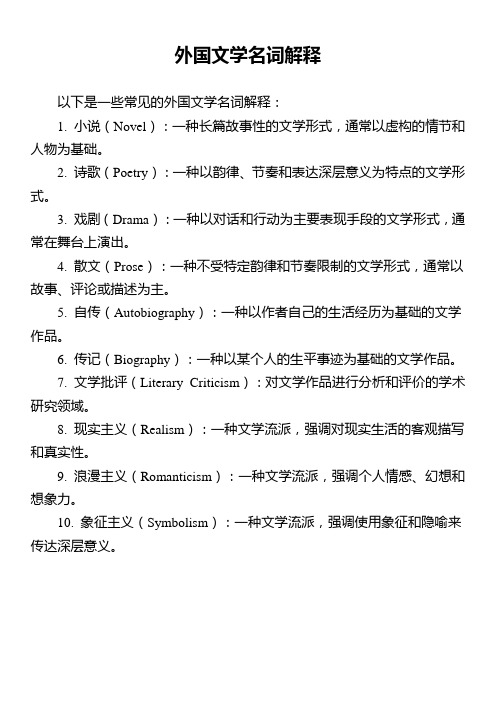
外国文学名词解释
以下是一些常见的外国文学名词解释:
1. 小说(Novel):一种长篇故事性的文学形式,通常以虚构的情节和人物为基础。
2. 诗歌(Poetry):一种以韵律、节奏和表达深层意义为特点的文学形式。
3. 戏剧(Drama):一种以对话和行动为主要表现手段的文学形式,通常在舞台上演出。
4. 散文(Prose):一种不受特定韵律和节奏限制的文学形式,通常以故事、评论或描述为主。
5. 自传(Autobiography):一种以作者自己的生活经历为基础的文学作品。
6. 传记(Biography):一种以某个人的生平事迹为基础的文学作品。
7. 文学批评(Literary Criticism):对文学作品进行分析和评价的学术研究领域。
8. 现实主义(Realism):一种文学流派,强调对现实生活的客观描写和真实性。
9. 浪漫主义(Romanticism):一种文学流派,强调个人情感、幻想和想象力。
10. 象征主义(Symbolism):一种文学流派,强调使用象征和隐喻来传达深层意义。
文学术语

1.poetry(un), poem/verse韵文/诗,poet诗人,poetess/woman poet女诗人,poetic有诗意的1.1.epic 史诗, epic writer史诗作者1.2.narrative poem叙事诗1.3.lyric poem抒情诗, lyrical有抒情意味的1.3.1. ode颂,sonnet十四行诗, ballad民谣, folk song民歌 etc.1.4. canto诗章, stanza诗段, line诗行, couplet二行诗段, quatrain四行诗段,etc., rhyme scheme/pattern韵脚, meter/foot音步1.5.iambic抑扬格的,trochaic扬抑格,anapestic抑抑扬格的,etc.2.prose(un)散文, prose writer散文作者, prosaic枯燥乏味的2.1.fiction(un)小说, fictional 虚构的2.1.1. novel长篇小说, novelist小说家2.1.2. novelette/novella中篇小说2.1.3. short story短篇小说2.1.4.viewpoint叙事角,the first-person narrator第一人称叙事角, the third-person narrator第三人称叙事角, the omniscient narrator全知叙事角, character人物protagonist=hero or heroine主角(女主角),antagonist 反面人物, setting背景(包括地点和时间)2.2.mythology(un)神话, myth神话故事2.3.folk lore(un)民间文学,legend民间传说,folk tale民间故事,fairy tale童话,fable(短篇)寓言故事etc.2.4.essay杂文/散文, essayist杂文作家2.5.literary criticism文学批评, critic评论家2.6.biography传记, biographer传记作家,autobiography自传2.7.prose narrative叙事散文3.drama(un), play戏剧, dramatist/playwright剧作家, dramatic激动人心的3.1.verse drama诗体戏剧, prose drama散文体戏剧3.2. tragedy悲剧, tragedian悲剧作家, tragic 悲惨的3.3. comedy喜剧, comedian戏剧作家, comic/ comical 滑稽好笑的3.4. tragic-comedy悲喜剧3.4.1.act幕, scene场/故事发生地点, dramatis persona(e)戏剧人物, prologue序幕,epilogue尾声,soliloquy(monologue)独白,aside(旁白),stage direction舞台提示,conflict戏剧冲突,climax戏剧高潮,denouement结尾, enter(人物上场), exit (pl. exeunt)人物退场,clown丑角4. miscellany混合类4.1. literature (n.),文学 literary(a.)文学的,man of letters文学家,romance传奇,allegory有道德教化意义的寓言式作品,satire讽刺作品etc.。
现将文学鉴赏常用术语列举如下
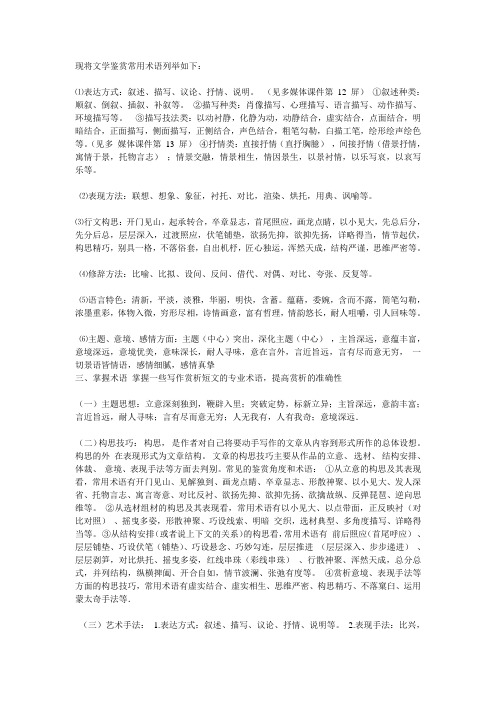
现将文学鉴赏常用术语列举如下:⑴表达方式:叙述、描写、议论、抒情、说明。
(见多媒体课件第12 屏)①叙述种类:顺叙、倒叙、插叙、补叙等。
②描写种类:肖像描写、心理描写、语言描写、动作描写、环境描写等。
③描写技法类:以动衬静,化静为动,动静结合,虚实结合,点面结合,明暗结合,正面描写,侧面描写,正侧结合,声色结合,粗笔勾勒,白描工笔,绘形绘声绘色等。
(见多媒体课件第13 屏)④抒情类:直接抒情(直抒胸臆),间接抒情(借景抒情,寓情于景,托物言志);情景交融,情景相生,情因景生,以景衬情,以乐写哀,以哀写乐等。
⑵表现方法:联想、想象、象征,衬托、对比,渲染、烘托,用典、讽喻等。
⑶行文构思:开门见山,起承转合,卒章显志,首尾照应,画龙点睛,以小见大,先总后分,先分后总,层层深入,过渡照应,伏笔铺垫,欲扬先抑,欲抑先扬,详略得当,情节起伏,构思精巧,别具一格,不落俗套,自出机杼,匠心独运,浑然天成,结构严谨,思维严密等。
⑷修辞方法:比喻、比拟、设问、反问、借代、对偶、对比、夸张、反复等。
⑸语言特色:清新,平淡,淡雅,华丽,明快,含蓄。
蕴藉,委婉,含而不露,简笔勾勒,浓墨重彩,体物入微,穷形尽相,诗情画意,富有哲理,情韵悠长,耐人咀嚼,引人回味等。
⑹主题、意境、感情方面:主题(中心)突出,深化主题(中心),主旨深远,意蕴丰富,意境深远,意境优美,意味深长,耐人寻味,意在言外,言近旨远,言有尽而意无穷,一切景语皆情语,感情细腻,感情真挚三、掌握术语掌握一些写作赏析短文的专业术语,提高赏析的准确性(一)主题思想:立意深刻独到,鞭辟入里;突破定势,标新立异;主旨深远,意韵丰富;言近旨远,耐人寻味;言有尽而意无穷;人无我有,人有我奇;意境深远.(二)构思技巧:构思,是作者对自己将要动手写作的文章从内容到形式所作的总体设想。
构思的外在表现形式为文章结构。
文章的构思技巧主要从作品的立意、选材、结构安排、体裁、意境、表现手法等方面去判别。
中国文学术语集
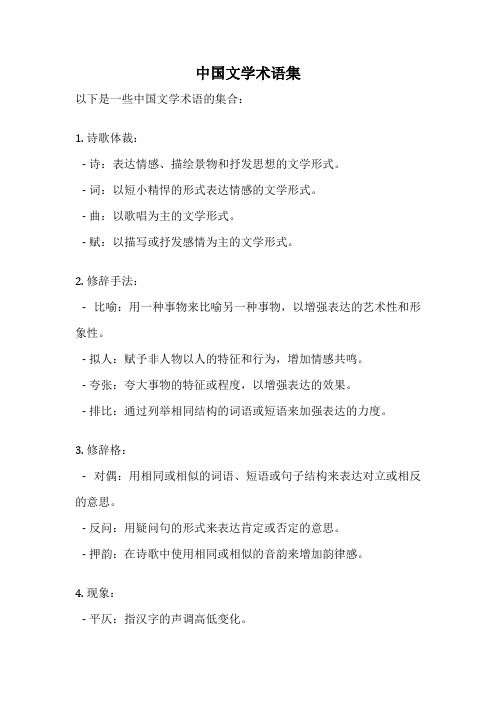
中国文学术语集
以下是一些中国文学术语的集合:
1. 诗歌体裁:
- 诗:表达情感、描绘景物和抒发思想的文学形式。
- 词:以短小精悍的形式表达情感的文学形式。
- 曲:以歌唱为主的文学形式。
- 赋:以描写或抒发感情为主的文学形式。
2. 修辞手法:
- 比喻:用一种事物来比喻另一种事物,以增强表达的艺术性和形象性。
- 拟人:赋予非人物以人的特征和行为,增加情感共鸣。
- 夸张:夸大事物的特征或程度,以增强表达的效果。
- 排比:通过列举相同结构的词语或短语来加强表达的力度。
3. 修辞格:
- 对偶:用相同或相似的词语、短语或句子结构来表达对立或相反的意思。
- 反问:用疑问句的形式来表达肯定或否定的意思。
- 押韵:在诗歌中使用相同或相似的音韵来增加韵律感。
4. 现象:
- 平仄:指汉字的声调高低变化。
- 押韵:在诗歌中使用相同或相似的音韵来增加韵律感。
- 韵律:诗歌中的节奏和音乐感。
5. 文学流派:
- 唐诗:盛行于唐朝的诗歌形式,以七言绝句为主要形式。
- 宋词:盛行于宋朝的短小精悍的诗歌形式。
- 元曲:盛行于元朝的戏剧形式,以曲子和对白相结合的形式。
这只是一些中国文学术语的集合,还有许多其他的术语和概念,用于描述和分析中国文学作品和文学创作的特点和风格。
古代文学术语

17 .含蓄与含混。含蓄是把似乎无限的意味隐含或蕴蓄在有限的话语中,使读者从有限中体味无限。含混,也称歧义、复义或多义等,则是指看似单义而确定的话语却蕴蓄着多重而不确定的意义空间,令读者回味无穷。比较而言,两者的不同在于:含蓄突出表达上的“小”中蓄“大”,含混则偏重阐释上的“一”中生“多”。但两者在实质上又是一致的:它们共同揭示出文学本文的话语系统具有丰富的意义生成可能性,即话语蕴藉特性。
21 .创作动机。创作动机是驱使作家投入文学创造活动的一股内在动力。
22 .艺术构思。艺术构思是作家在材料积累和艺术发现基础上,在创作动机指导下,以心理活动和艺术概括方式,创造完整的意象系列的思维过程。它是文学创造过程最实际、最紧张、也最重要的阶段。
23 .回忆与沉思。回忆是艺术构思的重要机制之一,它指积极地和有意义地从记忆中提取信息的心理过程。沉思则是在寂静和独处中对某个中心意念或意象加以深沉思索的心理过程。
12 .审美无功利性。这是由德国美学家康德提出的概念,认为审美具有不指向实际利益满足的特性。文学中的审美无功利性,是指作家或读者的创作或欣赏活动不指向直接的实际利益满足的特性。
13 .直觉。直觉,这里指审美直觉,是主体对于对象的不依赖概念而获得的瞬间领悟。
14 .文学的审美意识形态性质。这是对文学活动的特殊性质的概括,指文学是一种交织着无功利与功利、形象与理性、情感与认识等综合特性的话语活动。
37 .象征主义文学。象征主义文学是 19 世纪 70 年代兴起于欧洲的文学思潮,主张文学是作家的情感或理智的间接暗示的产物。代表人物有法国诗人马拉美、魏尔伦和兰波等。象征主义突出暗示性和朦胧性,主张以主观意识的客观对应物来暗示主观意识,建造一个寓意深长的符号世.即兴与推敲。即兴与推敲是物化阶段的两种不同操作方式,也是作品定型的两种不同手段。即兴是作家因外在刺激或内在冲动的作用而在文字操作过程中迅速创造出作品的情形。推敲是作家反复选择、调动词句以求准确和妥贴地把心象物化为定型作品的文字操作情形。即兴与推敲其实是同一操作过程的两个不同的侧面,不可绝对地分开。
文学术语

1. Allegory is a tale in verse or prose in which characters, actions, or settings represent abstract ideas or moral qualities.寓言是写成诗歌或散文形式的小故事其中人物、事件和场景代表抽象的观点或道德品质。
2. Alliteration is the repetition of the same initial consonant sound within a Line or a group of words.头韵是指在一行或一组词中第一个重读辅音的重复。
3. Allusion is reference to a person, a place, an event, or a literary work that a writer expects the reader to recognize and respond to.典故是作者对某些读者熟悉并能够作出反应的特定人物、地点、事件、文学作品的引用。
4. Analogy is a comparison made between two things to show the similarities between them.类比是为了在两个事物之间找出相似之处而进行的比较5. Antagonist is the principal character in opposition to the protagonist or hero or heroine of a narrative or drama.反面主角是叙事文学或戏剧中与男女主人公或正面人物相对立的主要人物6. Antithesis: the balancing of two contrasting ideas, words, or sentences.对仗指两组相对的思想、言辞、词句的平衡。
文学术语

1.后结构主义后结构主义者与它的结构主义前辈最明显不同的地方在于,他们抛弃了结构主义的简化主义方法论。
他们挑战结构主义宣称自己是能够诠释所有文本的批评后设语言(metalanguage),并且认为一个文本之外中立全知的观点是不可能存在的。
后结构主义者追求的是意符的无限扮演(play),并且不会给予任何一种阅读方法比其他方法还要更高的地位。
也因此,后结构主义领域中很少有互相一致的理论,但是每个理论都是从对结构主义的批判为起点。
后结构主义是针对历史相对论、意义与后文艺复兴的理性哲学批判的批判性理论,但反对结构性语言学为理论基础,强调片断不连续性,不相信历史进化和知识累积论.而后结构主义的研究是带有政治性的,因为许多后结构主义者相信,我们认为我们居住的这个世界事实上只是一个社会建构,在当中有许多不同的意识形态推动着想要成为霸权。
一些主要的后结构主义者有德里达、傅柯、罗兰·巴特(至少在后期的著作中)以及或许有争议的布希亚.2.解构主义在欧陆哲学与文学批评中,解构主义是一个由法国后结构主义哲学家德里达所创立的批评学派。
德里达提出了一种他称之为解构阅读西方哲学的方法。
大体来说,解构阅读是一种揭露文本结构与其西方形上本质(Western metaphysical essence)之间差异的文本分析方法。
解构阅读呈现出文本不能只是被解读成单一作者在传达一个明显的讯息,而应该被解读为在某个文化或世界观中各种冲突的体现。
一个被解构的文本会显示出许多同时存在的各种观点,而这些观点通常会彼此冲突。
将一个文本的解构阅读与其传统阅读来相比较的话,也会显示出这当中的许多观点是被压抑与忽视的。
解构主义流派反对结构主义,解构主义认为结构没有中心,结构也不是固定不变的,结构由一系列的差别组成。
由于差别在变化,结构也跟随着变化,所以结构是不稳定和开放的。
因此结构主义又被称为后结构主义。
德里达认为文本没有固定的意义,作品的终极不变的意义是不存在的。
文学理论基本术语

文学理论基本术语1. 文学四要素。
这是由美国批评家艾布拉姆斯(M.H. Abrams)在《镜与灯——浪漫主义文论及批评传统》提出的观点,认为文学活动由世界、作者、作品和读者四要素组成。
2. 模仿说。
这是古希腊有关文艺起源的学说,认为文艺起源于人对宇宙事物的模仿。
它内部存在两种对立观念,一种是以柏拉图为代表的否定性模仿说,认为艺术仅仅模仿世界的“影子的影子”,因而没有真理价值;另一种是以亚里士多德为代表的肯定性模仿说,与柏拉图的主张相反,认为艺术模仿世界同样能达到真理境界,这一主张后来成为现实主义文艺观的圭臬。
3. 观物取象说。
这是中国古代有关文艺起源的学说,认为文艺的起源与人“观”天地鸟兽的运动变化并加以模仿的行为有关。
4. 表现说。
这是西方18世纪以来随浪漫主义思潮而形成的学说,认为文学是作者心灵或情感的表现。
5. 言志说。
这是中国先秦产生的学说,认为诗歌是作者情感和志向的表现。
6. 文学本体论。
这是美国批评家兰塞姆(J. C. Ransom)提出的观点,认为文学活动的本体在于文学作品而不是外在的世界或作者。
作为本体的作品并不是指传统理论中作品的内容或是内容与形式的统一,而是仅仅指作品的形式。
7. 劳动说。
有关文学起源于劳动的学说,认为文学活动得以发生的根本原因是人类最基本的活动——劳动。
第一,劳动提供了文学活动的前提条件。
第二,劳动摧发了文学活动的需要,提供了文学的主要内容。
第三,在文学的早期形式上也体现了劳动的痕迹。
8. 不平衡说。
这是马克思恩格斯提出的有关艺术生产与物质生产之间关系的学说,认为艺术活动的发展与人类生产劳动的发展并不总是同步,或快或慢,有时甚至呈反方向发展。
这种“不平衡”有两种典范性表现:一种是某些文艺类型如神话和史诗只能兴盛于生产发展相对低级的阶段;另一种则是艺术生产与物质生产的发展水平不是呈正比例,经济落后的国家和地区可能在艺术上反而领先。
9. 循环说。
这是加拿大批评家弗莱(N. Frye)提出的有关文学发展动因的学说,认为文学的变化与自然节律相似,呈现出有规律的更替与循环过程,黎明和春天与喜剧对应,日午和夏天与传奇对应,日落和秋天与悲剧对应,黑暗和冬天与讽刺文学对应。
文学术语

1、知我者,谓我心忧,不知我者,谓我何求。
(诗经王风黍离)2、人而无仪,不死何为。
(诗经风相鼠)3、言者无罪,闻者足戒。
(诗经大序)4、他山之石,可以攻玉。
(诗经小雅鹤鸣)5、投我以桃,报之以李。
(诗经大雅抑)6、天作孽,犹可违,自作孽,不可活。
(尚书)7、满招损,谦受益。
(尚书大禹谟)8、从善如登,从恶如崩。
(国语)9、多行不义必自毙。
(左传)10、居安思危,思则有备,有备无患。
(左传)11、人非圣贤,孰能无过?过而能改,善莫大焉。
(左传)12、知人者智,自知者明。
(老子)13、信言不美,美言不信。
(老子)14、祸兮福之所倚,福兮祸之所伏。
(老子)15、合抱之木,生于毫末;九层之台,起于累土;千里之行,始于足下。
(老子)16、敏而好学,不耻下问。
(论语公冶长)17、己所不欲,勿施于人。
(论语颜渊)18、工欲善其事,必先利其器。
(论语卫灵公)19、君子坦荡荡,小人长戚戚。
(论语述而)20、岁寒,然后知松柏之后凋也。
(论语子罕)21、学而不思则罔,思而不学则殆。
(论语为政)22、知者不惑,仁者不忧,勇者不惧。
(论语子罕)23、人谁无过?过而能改,善莫大焉。
(论语)24、知之为知之,不知为不知,是知也。
(论语为政)25、知之者不如好之者,好之者不如乐之者。
(论语雍也)26、其身正,不令而行;其身不正,虽令不从。
(论语子路)27、三人行,必有我师焉:择其善而从之,其不善者而改之。
(论语述而)28、大道之行,天下为公。
(礼记礼运)29、凡事预则立,不预则废。
(礼记中庸)30、学然后知不足,教然后知困。
(礼记学记)31、玉不琢,不成器;人不学,不知道。
(礼记学记)32、路漫漫其修远兮,吾将上下而求索。
(屈原离骚)33、尺有所短,寸有所长。
(楚辞卜居)34、尽信书,不如无书。
(孟子尽心下)35、生于忧患,死于安乐。
(孟子告子下)36、得道多助,失道寡助。
(孟子公孙丑)37、民为贵,社稷次之,君为轻。
(孟子尽心上)38、穷则独善其身,达则兼济天下。
文学术语汇编

文学术语汇编11.Literature of the absurd: (荒诞派文学) The term is applied to a number of works in drama and prose fiction which have in common the sense that the human condition is essentially absurd, and that this condition can be adequately represented only in works of literature that are themselves absurd. The current movement emerged in France after the Second World War, as a rebellion against essential beliefs and values of traditional culture and traditional literature. They hold the belief that a human being is an isolated existent who is cast into an alien universe and the human life in its fruitless search for purpose and meaning is both anguish and absurd.2.Theater of the absurd: (荒诞派戏剧) belongs to literature of the absurd. Two representatives of this school are Eugene Ionesco, French author of The Bald Soprano (1949) (<秃头歌女>), and Samuel Beckett, Irish author of Waiting for Godot (1954) (<等待戈多>). They project the irrationalism, helplessness and absurdity of life in dramatic forms that reject realistic settings, logical reasoning, or a coherently evolving plot.3.Black comedy or black humor: (黑色幽默) it mostly employed to describe baleful, naïve, or inept characters in a fantastic or nightmarish modern world playing out their roles in what Ionesco called a “tragic farce”, in which the events are often simultaneously comic, horrifying, and absurd. Joseph Heller’s Catch-22 (美国著名作家约瑟夫海勒<二十二条军规>) can be taken as an example of the employment of this technique.文学术语汇编24. art for art’s sake: or the Aesthetic Movement(唯美主义): it began to prevail in Europe at the middle of the 19th century. The theory of “art for art’s sake” was first put forward by some French artists. They declared that art should serve no religious, moral or social purpose. The two most important representatives of aestheticists in English literature are Walt Pater and Oscar Wilde.5. Allegory(寓言): a tale in verse or prose in which characters, actions, or settings represent abstract ideas or moral qualities, such as John Bunyan’s The Pilgrim’s Prog ress. An allegory is a story with two meanings, a literal meaning and a symbolic meaning.6. Fable(寓言): is a short narrative, in prose or verse, that exemplifies an abstract moral thesis or principle of human behavior. Most common is the beast fable, in which animals talk and act like the human types they represent. The fables in Western cultures derive mainly from the stories attributed to Aesop, a Greek slave of the sixth century B. C.7. Parable(寓言): is a very short narrative about human beings presented so as to stress analogy with a general lesson that the narrator is trying to bring home to his audience. For example, the Bible contains lots of parables employed by Jesus Christ to make his flock understand his preach.8. Alliteration(头韵): the repetition of the initial consonant sounds. In Old English alliterative meter, alliteration is the principal organizing device of the verse line, such as in Beowulf.9. Consonance is the repetition of a sequence of two or more consonants but with a change in the intervening vowel, such as “live and love”.10. Assonance is the repetition of identical or similar vowel, especially in stressed syllables, in a sequence of nearby words, such as “child of silence”.11. Allusion (典故)is a reference without explicit identification, to a literary or historical person, place, or event, or to another literary work or passage. Most literary allusions are intended to be recognized by the generally educated readers of the author’s time, b ut some are aimed at a specialgroup.12. Ambiguity(复义性): Since William Empson(燕卜荪)published Seven Types of Ambiguity (《复义七型》), the term has been widely used in criticism to identify a deliberate poetic device: the use of a single word or expression to signify two or more distinct references, or to express two or more diverse attitudes or feeling.文学术语汇编313. Antihero(反英雄):the chief character in a modern novel or play whose character is totally different from the traditional heroes. Instead of manifesting largeness, dignity, power, or heroism, the antihero is petty, passive, ineffectual or dishonest. For example, the heroine of Defoe’s Moll Flanders is a thief and a prostitute.14. Antithesis(对照):(a figure of speech)An antithesis is often expressed in a balanced sentence, that is, a sentence in which identical or similar syntactic structure is used to express contrasting ideas. For example, “Marriage has many pains, but celibacy(独身生活)has no pleasures.” by Samuel Johnson obviously employs antithesis.15. Archaism(拟古):the literary use of words and expressions that have become obsolete in the common speech of an era. For example, the translators of the King James Version of Bible gave weight and dignity to their prose by employing archaism.16. Atmosphere(氛围): the prevailing mood or feeling of a literary work. Atmosphere is often developed, at least in part, through descriptions of setting. Such descriptions help to create an emotional climate to establish the reader’s expectations and attitudes.文学术语汇编417. Ballad(民谣):it is a song, transmitted orally, which tells a story. It originated and was communicated orally among illiterate or only partly literate people. It exists in many variant forms. The most common stanza form, called ballad stanza is a quatrain in alternate four- and three-stress lines; usually only the second and fourth lines rhyme. Although many traditional ballads probably originated in the late Middle Age, they were not collected and printed until the eighteenth century.18. Climax:as a rhetorical device it means an ascending sequence of importance. As a literary term, it can also refer to the point of greatest intensity, interest, or suspense in a story’s turning point. The action leading to the climax and the simultaneous increase of tension in the plot are known as the rising action. All action after the climax is referred to as the falling action, or resolution. The term crisis is sometimes used interchangeably with climax.19. Anticlimax(突降):it denotes a writer’s deliberate drop from the serious and elevated to the trivial and lowly, in order to achieve a comic or satiric effect. It is a rhetorical device in English. 20. Beat Generation(垮掉一代):it refers to a loose-knit group of poets and novelists, writing in the second half of the 1950s and early 1960s, who shared a set of social attitudes – antiestablishment, antipolitical, anti-intellectual, opposed to the prevailing cultural, literary, and moral values, and in favor of unfettered self-realization and self-expression. Representatives of the group include Allen Ginsberg, Jack Kerouac and William Burroughs. And most famous literary creations produced by this group should be Allen Ginsberg’s long poem Howl and Jack Kerouac’s On the Road.文学术语汇编521. Biography(传记):a detailed account of a person’s life written by another person, such a s Samuel Johnson’s Lives of the English Poets and James Boswell’s Life of Samuel Johnson.22. Autobiography(自传):a person’s account of his or her own life, such as Benjamin Franklin’s autobiography.23. Blank verse(无韵体): Verse written in unrhymed iambic pentameter. It is the verse form used in some of the greatest English poetry, including that of William Shakespeare and John Milton. 24. A parody(模仿)imitates the serious manner and characteristic features of a particular literary work, or the distinctive style of a particular author, or the typical stylistic and other features of a serious literary genre, and deflates the original by applying the imitation to a lowly or comically inappropriate subject.文学术语汇编625. Celtic Revival also known as the Irish Literary Renaissance (爱尔兰文艺复兴)identifies the remarkably creative period in Irish literature from about 1880 to the death of William Butler Yeats in 1939. The aim of Yeats and other early leaders of the movement was to create a distinctively national literature by going back to Irish history, legend, and folklore, as well as to native literary models. The major writers of this movement include William Butler Yeats, Lady Gregory, John Millington Synge and Sean O’Casey and so on.26. Characters(人物)are the persons represented in a dramatic or narrative work, who are interpreted by the reader as being endowed with particular moral, intellectual, and emotional qualities by inferences from the dialogues, actions and motivations. E. M. Forster divides characters into two types: flat character, which is presented without much individualizing detail; and round character, which is complex in temperament and motivation and is represented with subtle particularity.27. Chivalric Romance (or medieval romance) (骑士传奇或中世纪传奇)is a type of narrative that developed in twelfth-century France, spread to the literatures of other countries. Its standard plot is that of a quest undertaken by a single knight in order to gain a lady’s favor; frequently its central interest is courtly love, together with tournaments fought and dragons and monsters slain. It stresses the chivalric ideals of courage, loyalty, honor, mercifulness to an opponent, and elaborate manners.28. Comedy:(喜剧)in general, a literary work that ends happily with a healthy, amicable armistice between the protagonist and society.29. Farce (闹剧)is a type of comedy designed to provoke the audience to simple and hearty laughter. To do so it commonly employs highly exaggerated types of characters and puts them into improbable and ludicrous situations.30. Confessional poetry(自白派诗歌)designates a type of narrative and lyric verse, given impetus by Robert Lowell’s Life Studies, which deals with the facts and intimate mental and physical experiences of the poet’s own li fe. Confessional poetry was written in rebellion against the demand for impersonality by T. S. Elliot and the New Criticism. The representative writers of confessional school include Robert Lowell, Anne Sexton and Sylvia Plath and so on.31. Critical Realism:(批判现实主义)The critical realism of the 19th century flourished in the fouties and in the beginning of fifties. The realists first and foremost set themselves the task of criticizing capitalist society from a democratic viewpoint and delineated the crying contradictions of bourgeois reality. But they did not find a way to eradicate social evils. Representative writers of this trend include Charles Dickens and William Makepeace Thackeray and so on.32. Drama:(戏剧)The form of composition designed for performance in the theater, in whichactors take the roles of the characters, perform the indicated action, and utter the written dialogue. (The common alternative name for a dramatic composition is a play.)文学术语汇编733. Dramatic Monologue:(戏剧独白)a monologue is a lengthy speech by a single person. Dramatic monologue does not designate a component in a play, but a type of lyric poem that was perfected by Robert Browning. By using dramatic monologue, a single person, who is patently not the poet, utters the speech that makes up the whole of the poem, in a specific situation at a critical moment. For example, Robert Browning’s famous poem “My Last Duchess” was written in dramatic monologue.34. Elegy(哀歌或挽歌):a poem of mourning, usually over the death of an individual. An elegy isa type of lyric poem, usually formal in language and structure, and solemn or even melancholy in tone.35. Enlightenment(启蒙运动):The name applied to an intellectual movement which developed in Western Europe during the seventeenth century and reached its height in the eighteenth. The common element was a trust in human reason as adequate to solve the crucial problems and to establish the essential norms in life, together with the belief that the application of reason was rapidly dissipating the remaining feudal traditions. It influenced lots of famous English writers especially those neoclassic writers, such as Alexander Pope.36. Epic(史诗):it is a long verse narrative on a serious subject, told in a formal and elevated style, and centered on a heroic or quasi-divine figure on whose actions depends the fate of a tribe, a nation, or the human race.37. Epiphany:(顿悟)In the early draft of A Portrait of the Artist as a Young Man, James Joyce employed this term to signify a sudden sense of radiance and revelation that one may feel while perceiving a commonplace object. “Epiphany” now has become the standard term for the description, frequent in modern poetry and prose fiction, of the sudden flare into revelation of an ordinary object or scene.38. Epithet(移就): as a term in criticism, epithet denotes an adjective or adjectival phrase used to define a distinctive quality of a person or thing. This method was widely employed in ancient epics. For example, in Homer’s epic, the epithet like “the wine-dark sea” can be found everywhere.39. Essay:(散文)any short composition in prose that undertakes to discuss a matter, express a point of view, persuade us to accept a thesis on any subject, or simply entertain. The essay can be divided as the formal essay and the informal essay (familiar essay).40. Euphemism(委婉语): An inoffensive expression used in place of a blunt one that is felt to be disagreeable or embarrassing, such as “pass away” instead of “die”41. Expressionism(表现主义):a German movement in literature and the other arts which was at its height between 1910 and 1925 – that is, in the period just before, during, and after WWⅠ. The expressionist artist or writer undertakes to express a personal vision – usually a troubled or tensely emotional vision – of human life and human society. This is done by exaggerating and distorting. We recognize its effects, direct or indirect, on the writing and staging of such plays as Arthur Miller’s Death of a Salesman as well as on the theater of the absurd.42. Free verse(自由体诗):Like traditional verse, it is printed in short lines instead of with the continuity of prose, but it differs from such verse by the fact that its rhythmic pattern is notorganized into a regular metrical form – that is, into feet, or recurrent units of weak and strong stressed syllables. Most free verse also has irregular line lengths, and either lacks rhyme or else uses it only occasionally. Walt Whitman is a representative who employed this poem form successfully.文学术语汇编843. Gothic novel:(哥特式小说)It is a type of prose fiction. The writers of this type of fictions mostly set their stories in the medieval period and in a Catholic country, especially Italy or Spain. The locale was often a gloomy castle. The typical story focused on the sufferings imposed on an innocent heroine by a cruel villain. This type of fictions made bountiful use of ghosts, mysterious disappearances, and other supernatural occurrences. The principle aim of such novels was to evoke chilling terror and the best of this type opened up to the fiction the realm of the irrational and of the perverse impulses and nightmarish terrors that lie beneath the orderly surface of the civilized mind. Some famous novelists liked to employ some Gothic elements in their novels, such as Emily Bronte’s Wuthering Heights.44. Graveyard poets(墓园派诗歌): A term applied to eighteenth-century poets who wrote meditative poems, usually set in a graveyard, on the theme of human mortality, in moods which range from pensiveness to profound gloom. The vogue resulted in one of the most widely known English poems, Thomas Gray’s “Elegy Written in a Country Churchyard”.45. Harlem Renaissance(哈莱姆文艺复兴):a period of remarkable creativity in literature, music, dance, painting, and sculpture by African-Americans, from the end of the First World War in 1917 through the 1920s. As a result of the mass migrations to the urban North in order to escape the legal segregation of the American South, and also in order to take advantage of the jobs opened to African Americans at the beginning of the War, the population of the region of Manhattan known as Harlem became almost exclusively Black, and the vital center of African American culture in America. Distinguished writers who were part of the movement included Langston Hughes and Jean Toomer. The Great Depression of 1929 and the early 1930s brought the period of buoyant Harlem culture –which had been fostered by prosperity in the publishing industry and the art world – effectively to an end.46. Heroic Couplet(英雄双韵体)refers to lines of iambic pentameter which rhyme in pairs: aa, bb, cc, and so on. The adjective “heroic” was applied in the later seventeenth century because of the frequent use of such couplets in heroic poems and dramas. This verse form was introduced into English poetry by Geoffrey Chaucer. From the age of John Dryden through that of Samuel Johnson, the heroic couplet was the predominant English measure for all the poetic kinds; some poets, including Alexander Pope, used it almost to the exclusion of other meters.47. Hyperbole(夸张):this figure of speech called hyperbole is bold overstatement, or the extravagant exaggeration of fact or of possibility. It may be used either for serious or ironic or comic effect.48. Understatement(轻描淡写):this figure of speech deliberately represents something as very much less in magnitude or importance than it really is, or is ordinarily considered to be. The effect is usually ironic.49. Imagism(意象派):it was a poetic vogue that flourished in England, and even more vigorously in America, between the years 1912 and 1917. It was planned and exemplified by a group of English and American writers in London, partly under the influence of the poetic theory of T. E.Hulme, as a revolt against the sentimental and mannerish poetry at the turn of the century. The typical Imagist poetry is written in free verse and undertakes to be as precisely and tersely as possible. Meanwhile, the Imagist poetry likes to express the writers’ momentary impression of a visual object or scene and often the impression is rendered by means of metaphor without indicating a relation. Most famous Imagist poem, “In a Station of the Metro”, was written by Ezra Pound. Imagism was too restrictive to endure long as a concerted movement, but it influenced almost all modern poets of Britain and America.50. Irony(反讽):This term derives from a character in a Greek comedy. In most of the modern critical uses of the term “irony”, there remains the root sense of dissembling or hiding what is actually the case; not, however, in order to deceive, but to achieve rhetorical or artistic effects. 51. Local Colorism(地方色彩)was a literary trend belonging to Realism. It refers to the detailed representation in prose fiction of the setting, dialect, customs, dress and ways of thinking and feeling which are distinctive of a particular region. After the Civil War a number of American writers exploited the literary possibilities of local color in various parts of America. The most famous representative of local colorism should be Mark Twain who took his hometown near the Mississippi as the typical setting of nearly all his novels.52.Lyric(抒情诗):in the most common use of the term, a lyric is any fairly short poems consisting of the utterance by a single speaker, who expresses a state of mind or a process of perception, thought and feeling.53 回答问题Romanticism: In the most abstract terms, Romanticism may be regarded as the triumph of the values of imaginative spontaneity, visionary originality, wonder, and emotional self-expression over the classical standards of balance, order, restraint, proportion, and objectivity. Its name derives from romance, the literary form in which desires and dreams prevail over everyday realities.54 Byronic hero, characteristic of or resembling *Byron or his poetry; that is, contemptuous of and rebelling against conventional morality, or defying fate, or possessing the characteristics of Byron's romantic heroes, or imitating his dress and appearance; as *Meredith describes it, 'posturing statuesque pathetic'; or in the words of *Macaulay, 'a man proud, moody, cynical, with defiance on his brow, and misery in his heart, a scorner of his kind, implacable in revenge, yet capable of deep and strong affection'.55 回答问题Realism stressed 'sincerity' as opposed to the 'liberty' proclaimed by the Romantics; it insisted on accurate documentation, sociological insight, an accumulation of the details of material fact, an avoidance of poetic diction, idealization, exaggeration, melodrama, etc.; and subjects were to be taken from everyday life, preferably from lower-class life. This emphasis clearly reflected the interests of an increasingly positivist and scientific age.。
汉文 文学领域术语
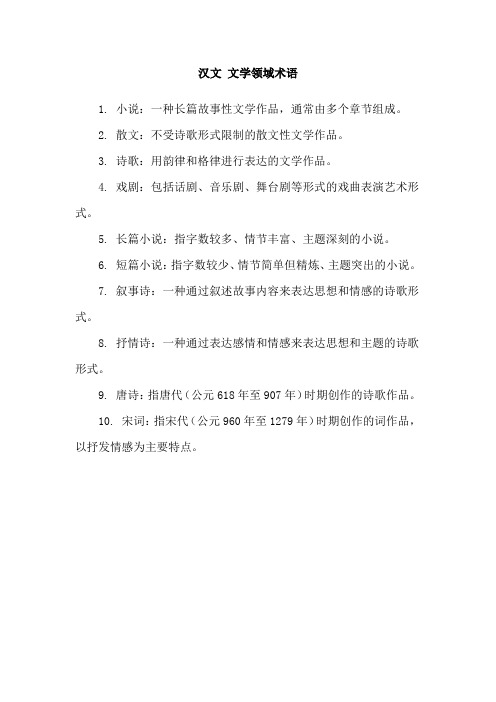
汉文文学领域术语
1. 小说:一种长篇故事性文学作品,通常由多个章节组成。
2. 散文:不受诗歌形式限制的散文性文学作品。
3. 诗歌:用韵律和格律进行表达的文学作品。
4. 戏剧:包括话剧、音乐剧、舞台剧等形式的戏曲表演艺术形式。
5. 长篇小说:指字数较多、情节丰富、主题深刻的小说。
6. 短篇小说:指字数较少、情节简单但精炼、主题突出的小说。
7. 叙事诗:一种通过叙述故事内容来表达思想和情感的诗歌形式。
8. 抒情诗:一种通过表达感情和情感来表达思想和主题的诗歌形式。
9. 唐诗:指唐代(公元618年至907年)时期创作的诗歌作品。
10. 宋词:指宋代(公元960年至1279年)时期创作的词作品,以抒发情感为主要特点。
续后汉书 文学领域术语
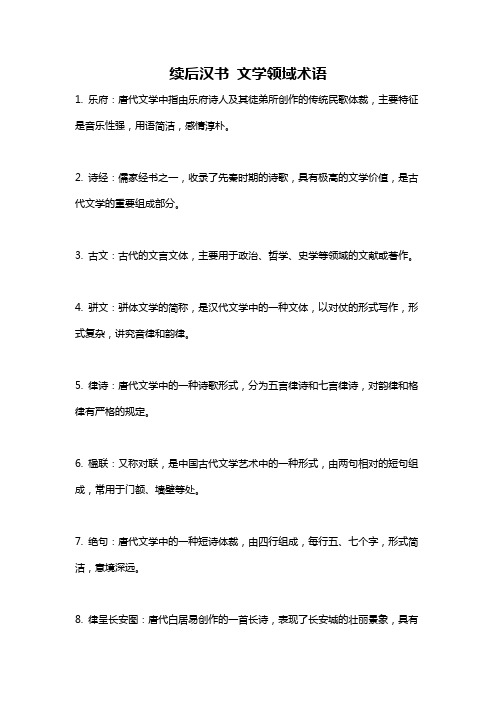
续后汉书文学领域术语
1. 乐府:唐代文学中指由乐府诗人及其徒弟所创作的传统民歌体裁,主要特征是音乐性强,用语简洁,感情淳朴。
2. 诗经:儒家经书之一,收录了先秦时期的诗歌,具有极高的文学价值,是古代文学的重要组成部分。
3. 古文:古代的文言文体,主要用于政治、哲学、史学等领域的文献或著作。
4. 骈文:骈体文学的简称,是汉代文学中的一种文体,以对仗的形式写作,形式复杂,讲究音律和韵律。
5. 律诗:唐代文学中的一种诗歌形式,分为五言律诗和七言律诗,对韵律和格律有严格的规定。
6. 楹联:又称对联,是中国古代文学艺术中的一种形式,由两句相对的短句组成,常用于门额、墙壁等处。
7. 绝句:唐代文学中的一种短诗体裁,由四行组成,每行五、七个字,形式简洁,意境深远。
8. 律呈长安图:唐代白居易创作的一首长诗,表现了长安城的壮丽景象,具有
很高的文学、历史、地理、艺术价值。
9. 赋:古代文学中的一种散文体裁,以描写景物、描写人物为主,以虚实生动、文气磅礴、言辞华丽为特征。
10. 辞赋:汉代文学中的一种文体,又称赋,是一种散文抒情体裁,注重描写景物、表现情感,代表作品有《离骚》、《天问》等。
纯文学作者术语

纯文学作者术语纯文学作者术语是指文学作者在写作过程中使用的一些特殊术语,它们可以帮助作者更好地表达自己的想法,更有效地传达文字的意义。
首先,纯文学作者术语包括文学作者使用的一些特殊词汇,如比喻、拟人、夸张、象征等。
比喻是指用一种物体来比拟另一种物体,以表达某种抽象的概念,如“他的心如钢铁般坚定”;拟人是指把某种物体或概念比作人,以表达某种抽象的概念,如“春天的脚步轻盈”;夸张是指用超出实际的语言来表达某种抽象的概念,如“他的智慧无可匹敌”;象征是指用某种物体来表达某种抽象的概念,如“白云象征着希望”。
其次,纯文学作者术语还包括文学作者使用的一些特殊句式,如排比、比喻句、拟人句、夸张句、象征句等。
排比是指用相同的句式把几个句子连接起来,以表达某种抽象的概念,如“他勤奋学习,刻苦钻研,不达目的,誓不罢休”;比喻句是指用比喻的方式来表达某种抽象的概念,如“他的心如钢铁般坚定”;拟人句是指用拟人的方式来表达某种抽象的概念,如“春天的脚步轻盈”;夸张句是指用夸张的方式来表达某种抽象的概念,如“他的智慧无可匹敌”;象征句是指用象征的方式来表达某种抽象的概念,如“白云象征着希望”。
最后,纯文学作者术语还包括文学作者使用的一些特殊修辞手法,如排比修辞、比喻修辞、拟人修辞、夸张修辞、象征修辞等。
排比修辞是指用排比的方式来表达某种抽象的概念,如“他勤奋学习,刻苦钻研,不达目的,誓不罢休”;比喻修辞是指用比喻的方式来表达某种抽象的概念,如“他的心如钢铁般坚定”;拟人修辞是指用拟人的方式来表达某种抽象的概念,如“春天的脚步轻盈”;夸张修辞是指用夸张的方式来表达某种抽象的概念,如“他的智慧无可匹敌”;象征修辞是指用象征的方式来表达某种抽象的概念,如“白云象征着希望”。
总之,纯文学作者术语是文学作者在写作过程中使用的一些特殊术语,它们可以帮助作者更好地表达自己的想法,更有效地传达文字的意义。
- 1、下载文档前请自行甄别文档内容的完整性,平台不提供额外的编辑、内容补充、找答案等附加服务。
- 2、"仅部分预览"的文档,不可在线预览部分如存在完整性等问题,可反馈申请退款(可完整预览的文档不适用该条件!)。
- 3、如文档侵犯您的权益,请联系客服反馈,我们会尽快为您处理(人工客服工作时间:9:00-18:30)。
文学术语Terms in English Literature1.Allegory (寓言)A tale in verse or prose in which characters, actions, or settings represent abstract ideas or moral qualities.寓言,讽喻:一种文学、戏剧或绘画的艺术手法,其中人物和事件代表抽象的观点、原则或支配力。
2.Alliteration (头韵)Alliteration is the repetition of the same initial consonant sound within a line or a group of words.头韵:在一组词的开头或重读音节中对相同辅音或不同元音的重复。
3.Allusion (典故)A reference to a person, a place, an event, or a literary work that a writer expects the reader to recognize and respond to.典故:作者对某些读者熟悉并能够做出反映的特定人物,地点,事件,文学作品的引用。
4.Analogy (类比)A comparison made between two things to show the similarities between them.类比:为了在两个事物之间找出差别而进行的比较。
5. Antagonist (反面主角)The principal character in opposition to the protagonist or hero or heroineof a narrative or drama.反面主角:叙事文学或戏剧中与男女主人公或英雄相对立的主要人物。
6. Antithesis (对仗)The balancing of two contrasting ideas, words, or sentences.对仗:两组相对的思想,言辞,词句的平衡。
7. Aphorism (警句)A concise, pointed statement expressing a wise or clever observation about life.警句:蕴含关于人生真理的明智的看法的精练的语句。
8. Aside (旁白)A piece of dialogue intended for the audience and supposedly not heard by other actors on stage.旁白:只说给观众而认为不会让台上其他演员听到的一段对话。
9.Apostrophe (呼语)The direct address of an absent or imaginary person or of a personified abstraction, especially as a digression in the course of a speech or composition.呼语:直接称呼不在场或虚构的人物或称呼拟人的事物,尤指作为演讲或作文过程中的离题话。
10.Assonance (类韵)The repetition of similar vowel sounds, especially in poetry.类音,类韵:相同或相似元音的重复,尤其指在诗歌中的重复。
11.Atmosphere (氛围)The prevailing mood or feeling of a literary work.12. Autobiography (自传)A person’s account of his or her own life.13. Ballad (民谣)A narrative poem, often of folk origin and intended to be sung.14. Ballad Stanza (民谣诗节)A type of four-line stanza, the first and the third lines have four stressed words or syllables; the second and fourth lines have three stresses.15. Biography (传记)A detailed account of a person’s life written by another person.传记:由他人撰写的关于某人生平的详细记录。
16.Blank Verse (无韵体诗)Verse written in unrhymed iambic pentameter.17. Caesura (休止)A break or pause in a line of poetry.18. Canto (章)One of the principal divisions of a long poem..诗章:一首长诗的主要部分之一。
19. Caricature (夸张讽刺)The use of exaggeration or distortion to make a figure appear comic orridiculous.夸张讽刺:为了使文中的人物显得可笑而使用的夸张或扭曲人物形象的手法。
20. Characterization (人物刻画)The means by which a writer reveals the personality of a character.人物刻画:作者表现作品中人物性格的方法。
21. Classicism (古典主义)A movement or tendency in art, literature, or music that reflects the principles manifested in the art of ancient Greece and Rome.古典主义:一种在文学,艺术,音乐领域体现古代希腊,罗马风格的运动。
22. Climax (高潮)The point of greatest intensity, interest, or suspense in a narrative.23. Comedy (喜剧)A dramatic work that is often humorous or satirical in tone and usually contains a happy resolution of the thematic conflict.喜剧:轻松的和常有幽默感的或在调子上是讽刺的戏剧作品,常包括主题冲突的愉快解决24. Conceit (奇想)A kind of metaphor that makes a comparison between two startlingly different things.奇想:一种在截然不同的事物之间建立起的比喻。
25. Conflict (冲突)A struggle between two opposing forces or characters in a short story, novel, play, or narrative poem.冲突:故事,小说,戏剧中相对的力量和人物之间的对立。
26. Connotation (外延)All the emotions and associations that a word or phrase may arouse.外延:包括单词字面意思之外的或被该词汇唤起的全部内涵的意义。
27. Consonance (辅音韵)The repetition of consonants or a consonant pattern, especially at the ends of words.辅音韵:辅音或辅音模式的重复,尤指位于词尾的。
28. Couplet (双韵体)A unit of verse consisting of two successive lines, usually rhyming and having the same meter and often forming a complete thought or syntactic unit.双韵体:包括两个相连的诗行的一种诗的单位,通常压韵并具有同样的格律,经常组成一个完整的意思和句法单位29. Heroic couplet (英雄双韵体)A couplet written in iambic pentameter is called a heroic couplet.英雄双韵体:五步抑扬格的双韵体称英雄双韵体。
30. Denotation (内涵)The literal or dictionary meaning of a word.直接意义:一个词的字面意义或词典意义。
31. Denouement (结局)The final resolution or clarification of a dramatic or narrative plot.结局:戏剧或叙事场景的最后结果。
32. Diction (措辞)A writer’s choice and use of words in speech or writing, particularly for clarity, effectiveness, and precision.措词:讲话或书写中,出于表述清晰,言简意赅对词语的使用或选择。
33. Dissonance (不协和)A harsh or disagreeable combination of sounds; discord.34. Dramatic monologue (戏剧独白)A kind of narrative poem in which one character speaks to one or more listeners whose replies are not given in the poem.35. Elegy (挽歌)A poem or song composed especially as a lament for a deceased person. 挽歌,挽诗:专门为悼念某一死者所写的诗或歌.36. Emblematic Image (象征)A verbal picture of figure with a long tradition of moral or religious meaning attached to it.37. Epic (史诗)An extended narrative poem in elevated or dignified language, celebrating the feats of a legendary or traditional hero.史诗:用严肃或庄重的语言写成的叙事长诗,歌颂传奇中或历史上英雄的丰功伟绩38. Epigram (隽语)A concise, clever, often paradoxical statement, usually in the form of a poem.隽语:一个简明,机智,常常似是而非的陈述,经常以诗的形式出现39. Epigraph (引语/开场白)A motto or quotation at the beginning of a literary composition, setting forth a theme.引语:在一部文学作品开头的引言,警句,阐明主题40. Epilogue (结语/收场白)A short addition or concluding section at the end of a literary work, often dealing with the future of its characters. Also called In this sense, also called afterword结语:文学作品结束时简短的附加或总结性章节,常常关于作品人物的未来也作在此意义上也可称作afterword.41. Epiphany(顿悟)A moment of illumination, usually occurs at or near the end of a work.顿悟:对现实真谛的顿悟或洞察,通常出现在作品的结尾.42. Epitaph(墓志铭)An inscription on a tombstone or in a short poem in memory of someone who has been dead.墓志铭:刻于墓碑上用以怀念死者的碑铭.43. Epithet (表述词语)A term used to characterize a person or thing。
